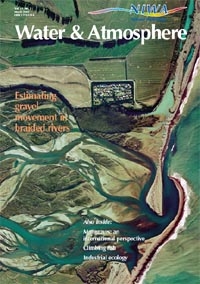PDF of this article (159 KB)

Anne-Maree Schwarz
The spread of mangrove forests – currently seen by some as a problem in some North Island estuaries – is by no means a global trend.
The value of mangrove (mānawa) ecosystems has recently been the topic of public debate in New Zealand, with discussions stimulated by the expansion of mangrove growth in some North Island estuaries. An inevitable question is asked when people are considering the rate of spread of mangroves in New Zealand: “Is the same thing happening in other places around the world?”
In this article we take a global perspective and ask how changes in mangrove distribution and related values in New Zealand compare to those elsewhere.
Trends: New Zealand
As a first step, understanding the extent of mangrove spread in North Island estuaries is not straightforward. The Land Cover Database (Terralink, NZ Ministry of Agriculture and Forestry) estimated a total area of mangroves of 22,200 ha for 1996/97. Various initiatives are underway to update this estimate. Although changes in some estuaries have been mapped from aerial photographs no accurate estimate of total change is available.

The value placed on mangrove ecosystems in New Zealand has had a chequered history. While Māori traditionally utilised both mangrove trees and the fish and shellfish from within mangrove forests, during the 20th Century mangroves were often not highly valued by an expanding New Zealand population. The State of New Zealand’s Environment Report (1997) describes how “...seagrass and mangrove ecosystems have declined this century as a result of widespread modifications to estuaries caused by activities such as infilling for agriculture, rubbish disposal and commercial land development”.
Changing attitudes toward the end of the century are reflected in the New Zealand Coastal Policy Statement (1994), which described a national policy for protecting ecosystems unique to the coastal environment and vulnerable to modification, including mangroves. Around that time there was a move towards conservation and education initiatives and investigations into means of replanting damaged mangrove forests. Now, less than a decade later, local authorities are being presented with applications for Resource Consents to remove mangroves from some areas.
Trends: elsewhere in the world
In 1997 the “World Mangrove Atlas” estimated the total global area of mangroves at ~18 million hectares. However, accurate current estimates remain elusive, complicated by a 2002 estimate by the ITTO (see panel) that, during the last decade, approximately 100,000 ha of mangroves have been destroyed annually. Notably, a survey in 1994/95 to study the global conservation status of mangroves found that “no mangrove areas were actively expanding”. (New Zealand was not included in the survey.) However there are examples from specific locations (for example, in Mozambique and Thailand) where, despite an overall reduction in mangrove area in the region, some bays have seen an increase in mangrove coverage. In both these cases, the expansion has been related to increases in sediment loading from the catchment.
Values
Mangroves occur at the interface between land and sea and are encroached upon by competing land-use, as well as being indirectly affected by catchment development. From this perspective, the same general considerations for management of mangrove ecosystems apply globally. So what are the values and how do they differ from place to place?
Ecological values
There are over 60 species of mangroves worldwide, of which about a quarter are of the genus Avicennia. Avicennia marina (grey mangrove) has the widest latitudinal distribution and is the only species of mangrove represented in New Zealand. Like all mangroves, Avicennia forests contribute to marine food webs through production of detritus, and several marine organisms spend all or part of their lifecycles there.
Economic values
Mangroves provide livelihoods for millions of people throughout the world thereby providing tangible economic benefits. The cases summarised below (with examples of relevant countries) include values that, due to exploitation, can also contribute to mangrove decline:
- Mangrove poles are extensively used for the construction of houses because the wood of many species is durable and resistant to termites. However unregulated cutting for timber, firewood, charcoal or pulp results in cleared land being converted to other types of land-use (Micronesia, India, Ecuador, Latin America, Madagascar, Pacific Islands, Thailand, Vietnam).
- Mangrove forests are cleared to make way for brackish-water shrimp farms and salt ponds, sometimes leaving an unsustainable fringe of mangroves between the ponds and the sea (Indonesia, Sri Lanka, Latin America).
- Land colonised by mangroves is reclaimed for housing and resort development (Australia, USA, Malaysia, Belize, Madagascar, South Africa) or is used for dumping rubbish (Venezuela, Pacific Islands).
As recently as the 1970s New Zealand’s mangrove forests were being reclaimed for various types of land development including roading, oxidation ponds and agriculture, and were also used as tip sites. There is no mangrove timber industry here, but mangroves continue to support ecological values, traditional Māori values and other community values.
Indirect effects on mangrove values

Of other human activities that have indirect effects on these values, catchment management is probably of most relevance in New Zealand.
Here, recent increases in mangrove area have been attributed at least in part to accelerated erosion of catchment sediments into our estuaries, providing more suitable conditions for mangrove colonisation. Compare this with the situation in some other countries, where catchment development has sometimes had the effect of reducing the area of mangroves. In Micronesia, India, Pakistan and Brazil, for example, damming of rivers has reduced sediment load, starving mangrove forests of sediment. Elsewhere in India, extreme siltation has changed the path of freshwater inflows so that mangroves no longer receive sufficient tidal flushing.
As in New Zealand, attitudes to exploitation of mangrove forests have changed in other parts of the world. Partly because of the global decline in mangroves (noted above), in some places there is now a strong emphasis on conservation, sustainable management and restoration. The ITTO Mangrove Workplan (2002) stated:
“it is widely believed that after total felling a [mangrove] forest will regenerate spontaneously. On the contrary this happens under very special conditions and usually with human assistance.”
Because of this, attempts to establish nurseries and re-plant mangroves are the focus of a projects in many regions, including the USA, Thailand, and Latin America (e.g., Colombia) as well as closer to home in Fiji.
Mangrove spread: a New Zealand phenomenon
It seems there is no hard and fast rule about spread or decline that can be applied to all mangrove ecosystems. There are places where mangrove forests are relatively untouched, are in dramatic decline, have been completely destroyed, are spreading seaward into estuarine areas, or, in places that are affected by sea-level rise, are spreading landward onto adjacent river plains. Nevertheless, it is generally accepted that on a global scale the area of mangroves is in decline and that mangrove ecosystems are under threat.
Teachers: this article can be used for Biology L7 A.O. 7.3a, and NCEA AS 2.4, 2.5 and 2.9. See other curriculum connections at www.niwa.co.nz/pubs/wa/resources
Thus, with few exceptions, the trend for spread of mangroves that has been recently observed in some of our estuaries does appear to be a relatively local phenomenon at present. This is mostly a result of different values and different degrees of catchment and coastline development, all of which are likely to continue to change in the future, not only in New Zealand but also elsewhere in the world.
NB: the PDF of this article includes additional illustrations.
International Tropical Timber Organisation (ITTO)
Many different research and interest groups around the world are working on mangrove management and conservation. One of these is the International Tropical Timber Organization, which counts mangrove timber amongst its global products. In 2002 ITTO organised a workshop in Colombia, South America, providing for a New Zealand representative (from NIWA) to attend. The objective of the workshop was to draft a mangrove work plan to guide ITTO members in the development of projects for sustainably managing and conserving their mangrove resources. While New Zealand is a consumer of tropical timber rather than a provider, the presentations made at that meeting provided a useful background for a general discussion of the “global” status of mangroves.
Further reading
Bradstock, M. (1989). Between the tides. David Bateman Ltd, Auckland. 158 p.
Green, M.; Ellis, J.; Schwarz, A.; Green, N.; Lind, D.; Bluck, B. (2003). For and against mangrove control. NIWA Information Series No. 31. 8 p.
Nicholls, P.; Ellis, J. (2002). Fringing habitats in estuaries: the sediment–mangrove connection. Water & Atmosphere 10(4): 24–25.
Walsby, J.; Torckler, D. (1992). Forests in the sea. New Zealand Geographic 15: 40–64.
NIWA continues to research the effects of sediment loadings to estuaries on the rate of mangrove spread, the role of nutrients in mangrove growth, and the relative value of mangrove habitat for estuarine fauna. For further information on any of these topics, contact Anne-Maree Schwarz, Mal Green, or Pip Nicholls at NIWA, PO Box 11115, Hamilton (ph 07 856 7026, fax 07 856 0151, [email protected])
